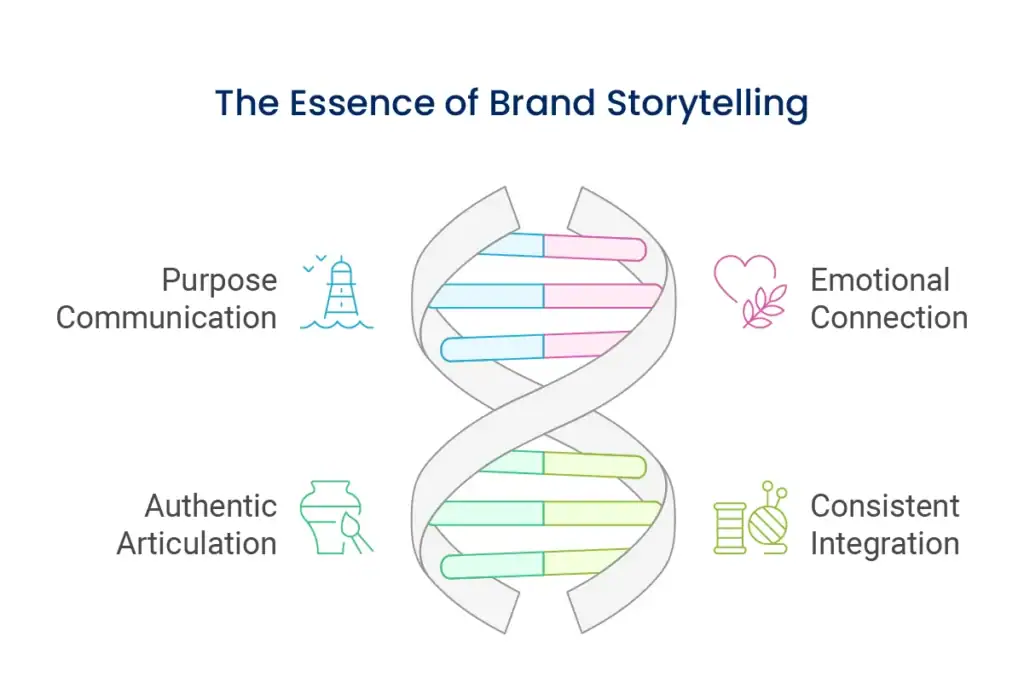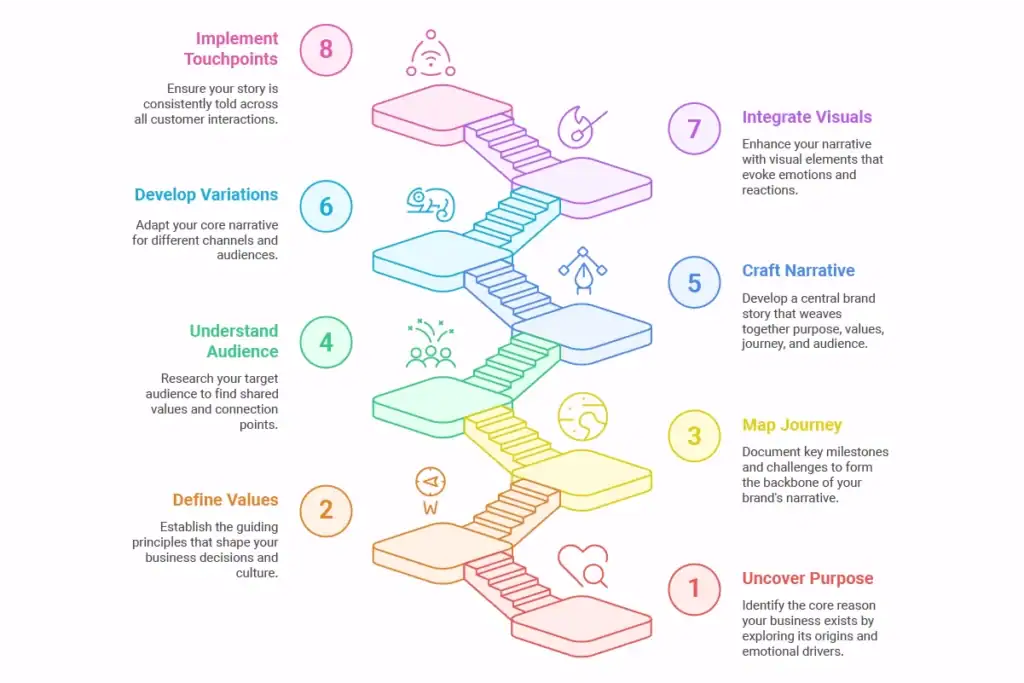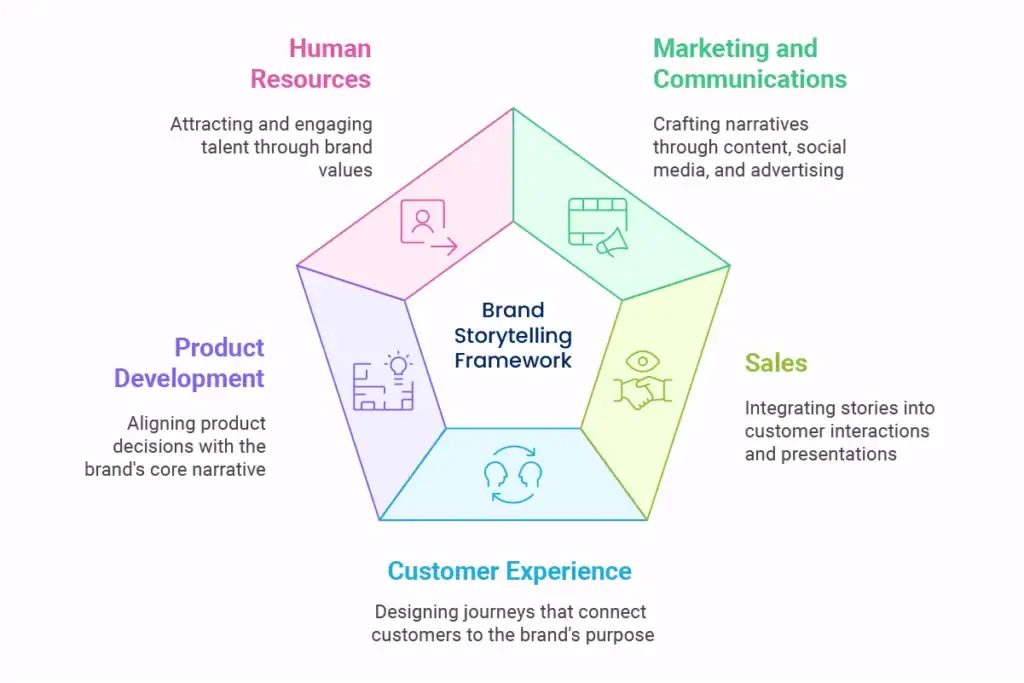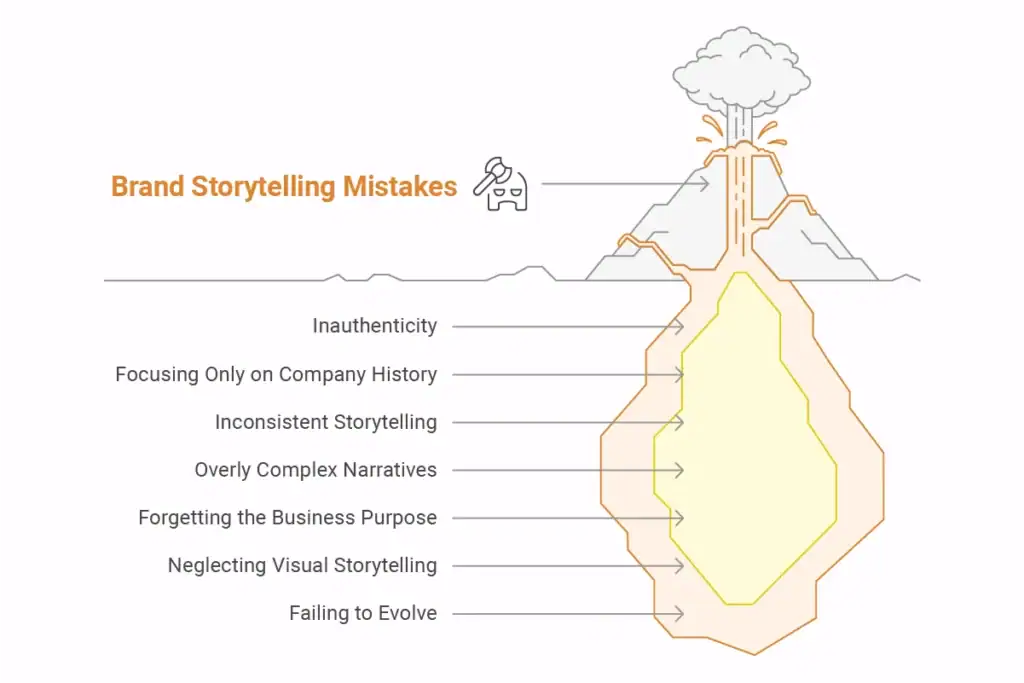Our Core Services
Brand Storytelling: Weaving Purpose, Values and Vision into Compelling Narratives
“What’s your story?” When a potential customer asks this question about your company, do you have a solid, engaging response that grabs attention and sparks connection? If not, you’re passing up a strong chance to separate your brand in a dense marketplace. Brand storytelling turns regular businesses into exceptional brands by crafting compelling stories that customers recall, identify with, and desire to be a part of.
At its core, successful brand storytelling isn’t about inventing fiction—it’s about truthfully sharing who you are, why you exist, and how you make an impact in ways that connect at the emotional level with your audience. This page delves into how to build and utilize brand stories that not only engage but convert, turning passive leads into passionate champions.

Table of Content
What is Brand Storytelling?

Brand storytelling is the intentional application of story to share your company’s purpose, values, and vision in a manner that builds emotional connections with your audience. While traditional marketing emphasizes largely product features and benefits, brand storytelling burrows into the “why” of your business and the difference you make.
Good brand storytelling isn’t lying—it’s explaining. It’s taking the real pieces of your business personality and crafting them into clear, compelling stories that make people get it not only about what you do but why it’s important and why they should give a damn.
Great brand storytelling is woven throughout every touch point of your company—your website and marketing collateral, the way your staff interacts with customers, and the entire experience you deliver. Done effectively, they form the basis on which great, long-term customer relationships are established.
Why Brand Storytelling Matters for Your Business
The business value of a powerful brand story goes far beyond merely “sounding good.” Here’s why an investment in your brand story pays real returns:

Creates Memorable Differentiation
In industries where products and services increasingly begin to look the same, your story is usually the most unique thing about you. A great brand story makes you stand out where features and benefits cannot alone.
Creates Emotional Connection
Humans decide on a gut level and rationalize later. Emotionally resonant brand stories cut through resistance based on reason and connect more strongly than reason-based selling alone.
Adds Perceived Value
Meaningful-story companies always charge more than commodity rivals. Your story delivers value that goes beyond utilitarian use.
Drives Customer Loyalty
When customers engage with your story, they're investing in something greater than a transaction—they're joining your purpose and values, driving stronger loyalty and retention.
Attracts Aligned Talent
A powerful brand story doesn't only bring customers in—it brings employees who share your values and purpose, creating stronger teams and culture.
Makes Marketing Simpler
With a clear, consistent narrative, content creation becomes second nature and your message becomes clearer and more cohesive across channels.
Key Elements of Effective Brand Storytelling

1. Purpose-Driven Narrative
The strongest brand narratives revolve around purpose—the very reason your business exists outside of profiteering. This core “why” is the essence of your story and the basis for true storytelling.
Your mission-oriented story addresses questions such as: Why did your founders found this company? What issue were they enthusiastic about fixing? What do you desire to change in the world? What would be missing if your company had not existed?
Purpose-driven stories provide people with something substantial to relate to and rally around. They turn transactions into participation in something greater and more meaningful.
2. Character and Personality
All great stories require interesting characters, and in brand storytelling, your brand is the character that becomes the hero with its own personality characteristics, values, and voice.
Defining the character of your brand involves deciding: Is your brand serious or playful? Sophisticated or friendly? Classic or radical? Authoritative or collaborative? These personality characteristics influence the way your story is told and how the audience perceives you.
The best brand characters are consistent yet demonstrate depth and humanity. Consider them as fully realized characters, not stereotypes.
3. Authentic Brand Values
Values are the moral compass of your brand narrative—the guiding principles that inform your choices and behaviors, particularly when the going gets tough or ethics come into play.
Your values must be authentic expressions of what your business actually believes and does, not statements of how you wish to be. They respond: What do you stand for? What will you not trade away? What rules do you live by when no one’s looking?
Values give your brand story the “character development,” illustrating what’s most important and providing people with moral reasons to join your cause.
4. Emotional Narrative Arc
All great tales of power have a narrative format that engages people emotionally. Your brand’s story must have an evident arc that creates tension, resolution, and change.
Typically, this involves elements such as:
- The first challenge or issue that led to your business
- Challenges and setbacks overcome
- Most significant turning points and breakthroughs
- Current situation and continued mission
- Vision of a better future that you’re striving for
Emotional story patterns build investment in the outcome of your story and cause people to feel they are along for an unfolding journey instead of merely a static business offer.
5. Customer-Centred Perspective
While your brand should be the hero of your story, your customer should be the one you are assisting in success. Good brand storytelling puts the customer’s needs, desires, and challenges at the forefront of the narrative.
This shift in perspective repositions your brand from hero to guide—the sage advisor who offers instruments, insights, and assistance that allows the customer-hero to overcome obstacles and fulfill their intentions.
Customer-focused storytelling illustrates that you know your listeners profoundly and are invested in their achievement beyond simply selling to them.
How to Develop Your Brand Story: A Step-by-Step Guide
Ready to write a brand story that connects and converts? Here’s a practical step-by-step process:

Discover Your Real Purpose
Begin by digging up the genuine reason your company exists. Interview founders and veteran employees why they began or became a part of the firm, what issues they were eager to solve, and what impact they wanted to create. Search for commonalities and motivational underpinnings that transcend profit drives. Boil these findings down into a concise purpose statement that encapsulates the very "why" of your brand.
Execute Across Touchpoints
Map out all of your customer touchpoints and map out how your story plays out at each, from website and packaging to customer service scripts and sales presentations. Develop guidelines for consistent storytelling while still permitting contextual, authentic expression. Don't forget that stories are communicated through experience, not only communication—every touchpoint either supports or defeats your story.
Define Your Core Values
Determine the 3-5 principles that truly lead your business decisions and actions. Rather than such generic values as "integrity" or "excellence," define specific beliefs that are exclusive to your company culture. Ask yourself for each value: "Would we continue this principle even if it cost us money or convenience?" Only real values can withstand this test. After defining them, describe each value with examples of how it plays out in real business practices.
Map Your Brand's Journey
Write down your company's major milestones, challenges that were overcome, and turning points that defined your identity. This timeline serves as the foundation of your unfolding narrative. Add both successes and failures because true stories recognize hardships in addition to victories. Cull the lessons, wisdom, and character building from every major moment.
Know Your Audience's Story
Learn about your target audience's pain points, aspirations, values, and emotional drivers. Develop in-depth customer personas that reflect their stories and pain points. Find areas of intersection between their story and your brand story—those intersection points become the basis for compelling messaging. Seek common values and complementary missions that drive natural fit.
Write Your Central Story
With the insights gained in steps 1-4, create your central brand story that threads together your purpose, values, history, and audience connection. Frame this story with a distinct beginning (the problem or opportunity you identified), middle (your approach and what sets it apart), and future vision (the improved world you're contributing to). Make this central narrative brief, memorable, and emotive.
Create Story Variations for Various Contexts
From your original narrative, develop variations suitable for different channels, audiences, and uses. These may be your origin story, vision story, customer success stories, product stories, and impact stories. Every variation should be consistent with your original narrative while highlighting aspects most appropriate for particular contexts.
Combine Visual Storytelling Elements
Create visual elements that enhance your story, such as photography style, illustration technique, colour psychology, typography mood, and brand identity design elements. Visual storytelling tends to speak on emotional levels not accessed by words alone, evoking instant gut responses before logical processing commences.
Implementing Brand Storytelling Across Business Functions
Successful brand storytelling reaches well beyond marketing into all the corners of your organization. Here are ways that various departments can tap and support your core story:

1. Marketing and Communications
Content Marketing
Create blog articles, videos, and podcasts that dive into various aspects of your brand narrative, showcasing your purpose and values at work.
Social Media
Post micro-stories and behind-the-scenes moments that personalize your brand and reveal your story in real time.
Advertising
Emotionally centered campaigns over simply features and benefits, leveraging your brand history to make memorable, sharable content.
2. Sales
Customer Conversations
Educate sales teams to incorporate appropriate aspects of your brand narrative into prospect conversations, aligning narrative elements with particular customer pain points.
Proposals and Presentations
Design sales materials as story trips that put your company in the customer's success guide position.
Objection Handling
Employ narrative elements to respond to objections genuinely—your purpose and values tend to demolish objections more powerfully than technical answers.
3. Customer Experience
Onboarding
Craft the new customer experience as a continuation of the story, linking their choice to your common purpose and foreshadowing what changes they can expect.
Support Interactions
Enable support staff to uphold your values by the manner in which they resolve issues and interact with customers.
Loyalty Programs
Position continuous relationships as journey milestones to be shared, not transactional rewards.
4. Product Development
Feature Prioritisation
Employ your values and purpose as filters for product decisions, so developments are consistent with your core story.
Product Naming and Messaging
Tie product language back to your core story, establishing narrative coherence throughout your offering.
User Experience
Create interfaces and experiences that reflect your brand personality and engage customers as heroes of your shared narrative.
5. Human Resources
Recruitment
Recruit like-minded talent by leadership through purpose and values instead of merely job descriptions and rewards.
Onboarding
Introduce new employees into your brand narrative from day one, assisting them in discovering their role in the story.
Internal Communications
Embed your narrative internally through congruent communication that ties daily work to a greater purpose.
Common Brand Storytelling Mistakes to Avoid
Even the best-intentioned attempts at storytelling can fail if these widespread missteps are not taken into consideration:

Inauthenticity
Developing inspirational stories that are removed from your real-life business procedures builds credibility gaps viewers immediately identify. Have your story mirror genuine internal culture and values.
Only Emphasizing Company History
Although beginnings are important, successful brand storytelling is customer-inclusive and forward-thinking. Incorporate heritage with vision and steer clear of egocentric storytelling.
Inconsistent Storytelling
Contradictory messages across touchpoints shatter narrative coherence. Establish clear storytelling principles and make sure that all teams know your foundational story.
Forgetting the Business Purpose
Authentic and emotional as your brand story may be, it still must drive business outcomes. Regularly assess whether your narrative is building significant connections that translate to desired actions.
Overlooking Visual Storytelling
Exclusively depending on words overlooks great chances to engage through images, design, and experiences. Invest in visual forms of your story.
Missing the Mark on Evolution
Immobilized stories become stagnant and outdated. Create systems to adapt your story as your business develops and markets shift, keeping core purpose and values intact.
Measuring Brand Storytelling Effectiveness
How do you know if your brand storytelling efforts are working? Track these metrics:
Quantitative Indicators
Brand Sentiment
Track social listening metrics for shifts in how individuals talk about your brand.
Engagement Metrics
Track time spent, sharing, and interaction with narrative-driven content compared to product-driven materials.
Conversion Rates
Monitor if story-driven campaigns trigger greater conversion than conventional methods.
Premium Price Capability
Evaluate willingness to pay higher than market averages as storytelling evolves.
Qualitative Indicators
Story Recall
Are customers able to accurately describe your purpose and values?
Emotional Connection
Are customers describing their connection with your brand in emotional language?
Internal Alignment
Are workers making decisions aligned with your story?
Recruitment Quality
Are you recruiting candidates who are particularly attracted to your cause?
Final Thoughts: The Strategic Art of Brand Storytelling
In an increasingly difficult-to-differentiate business environment, your brand narrative could be your most enduring competitive edge. Unlike imitable products or technologies whose times will pass, an honest story based on true purpose and values is yours alone.
The best-performing brands are not simply telling stories—s/he’s crafting narrative ecosystems in which customers discover meaning, belonging, and identity through their identification with the brand. By carefully creating and consistently implementing your brand storytelling strategy, you turn transactions into relationships and products into experiences.
Keep in mind that great brand storytelling isn’t something you master and use for all time—it’s a developing practice that expands and evolves with your company while retaining fundamental narrative integrity. Begin where you’re at, from the true aspects of purpose and value already present in your company, and develop your storytelling capability intentionally over time.
Need Help Developing Your Brand Story?
If you want to discover, create, or enact a brand story that actually resonates with your consumers and drives business outcomes, seeking professional assistance can expedite your journey. Strategic brand management solutions can assist you in discovering your genuine narrative components and designing storytelling systems that establish enduring worth.
